Automotive Smart Antenna Market by Frequency (High, Very High, & Ultra High), Type (Shark-Fin & Fixed Mast), Component (Transceivers, ECU), Vehicle Type (Passenger Cars, LCV, & HCV), EV (BEV, FCEV, & PHEV) and Region - Global Forecast to 2030
[257 Pages Report] The Automotive Smart Antenna Market is projected to grow from USD 2.5 Billion in 2023 to USD 5.2 Billion by 2030, at a CAGR of 10.9%. The key factors driving the automotive smart antenna market are the increase in sales of mid- & premium segment cars EVs and SUV sales. Growing cellular applications for connected vehicles, rising demand for safety features, growing use of Electrical/Electronic (E/E) architecture, and increasing EV sales are driving the automotive smart antenna market.
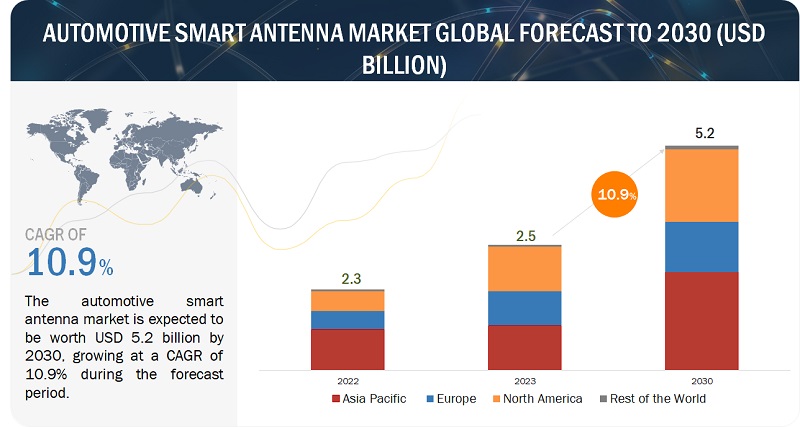
To know about the assumptions considered for the study, Request for Free Sample Report
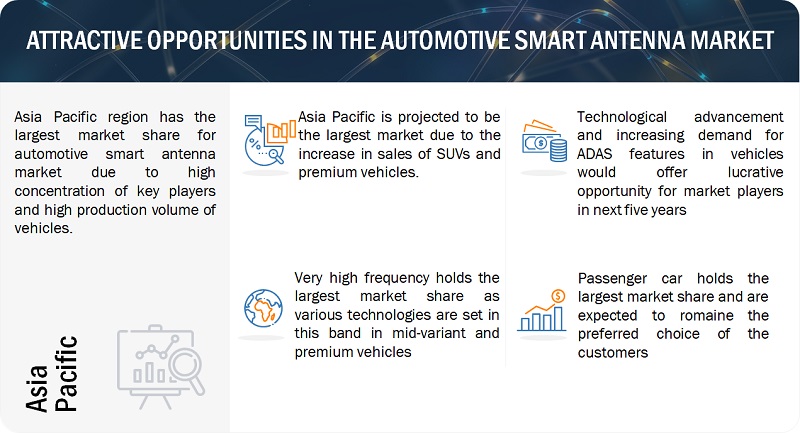
To know about the assumptions considered for the study, download the pdf brochure
Market Dynamics
DRIVER: Growing cellular applications for connected vehicles
The data rate cost regarding spectrum usage has been reduced with successive generations of mobile networks. There have been various advancements in wireless networks in recent years. Each generation of the cellular network is faster, more secure, and more reliable than the previous one. However, the rise of 5G connectivity has been a key driver, with smart antennas optimized for 5G networks to provide high-speed, low-latency communication. Utilizing advanced technologies such as beamforming and MIMO, smart antennas improve signal quality, ensuring reliable connectivity in various environments.
Current 4G networks do not have the capacity or speed to enable a truly connected experience and deliver safe and reliable services. However, 5G technology has boosted OEMs by testing many non-safety V2X applications, such as weather, road conditions, and traffic data between vehicles. The enhanced safety features, including advanced driver assistance systems (ADAS) and vehicle-to-everything (V2X) communication, benefit from the improved reliability and speed of data transfer facilitated by smart antennas. Additionally, these antennas enable over-the-air (OTA) updates, allowing manufacturers to enhance vehicle functionality and security remotely. The growing consumer demand for vehicle connectivity features and regulatory requirements promoting intelligent transportation systems further contribute to the increasing adoption of smart antennas in the automotive sector.
Key automotive sector players invest heavily in 5G infrastructure to increase connectivity and data transfer rates. For instance, China Mobile (China) has invested USD 36 billion in 5G infrastructure. The company has focused on covering over 800 cities within China, highlighting widespread connectivity and digitalization. In July 2023, American Tower invested USD 1 billion in fiber optic network expansion to support 5G deployments, which will have a faster speed with lower latency. In February 2021, Verizon (US) was the top bidder worth USD 45 billion investment in 5G spectrum and network deployment for the future of connectivity and connected vehicles in the US.
The substantial investments by key players in developing 5G infrastructures further amplify the potential for groundbreaking innovations in connectivity to enhance the connected automotive vehicle driving experience. This will drive the adoption of automotive smart antennas in the cellular application segment.
RESTRAINT: Lack of communication infrastructure in emerging economies
An The expansion of the automotive smart antenna market is significantly hindered in emerging economies due to inadequate communication infrastructure. The deficient condition of communication infrastructure in countries like Sub-Saharan Africa (Ethiopia and Keney) and Central Asia (Turkmenistan and Tajikistan) substantially restrain the widespread integration of automotive smart antennas. The limitations in 4G or 5G networks severely impede the smart antenna's capability to deliver high-speed and low-latency communication, essential for applications like autonomous driving and V2X communication. Hence, remote and rural areas with connectivity gaps hinder the seamless operation of smart antennas and limit their potential benefits in terms of enhanced safety features and improved traffic management.
Furthermore, over-the-air (OTA) updates, essential for improving performance and ensuring security, have become challenging in countries with inadequate communication infrastructure. Smart antennas may struggle to receive timely updates, impacting their functionality and potentially leaving vehicles with outdated software and firmware. The security and reliability concerns related to data transmission are heightened in countries with inadequate or unreliable communication networks. The lack of a robust infrastructure exacerbates these issues, creating barriers to realizing the full advantages of smart antennas in connected vehicular systems. The ongoing initiatives and collaborations between governments, international entities, and industry stakeholders to address these infrastructure gaps indicate a recognized need for targeted investments. Despite positive strides, the current communication infrastructure in emerging economies remains a formidable restraining factor, necessitating sustained efforts to bridge the digital divide and fully unlock the potential of smart antennas in these economies. For instance, in Lagos (Nigeria), smartphone penetration is lower than in developed countries. This limits the potential customer base for smart antenna-equipped vehicles, making manufacturers hesitant to invest heavily in these technologies for such markets.
Hence, the restrained growth of the automotive smart antenna market in emerging economies can be attributed to the persistent lack of robust communication infrastructure. However, addressing this challenge presents an opportunity for collaborative efforts among governments, private sector stakeholders, and international organizations to invest in and develop comprehensive communication networks. By strategically addressing infrastructure gaps, fostering innovation, and implementing targeted policies, the market can overcome barriers and unlock its full potential, ensuring seamless connectivity and the integration of advanced technologies in vehicles within these economies.
OPPORTUNITY:New revenue opportunity in autonomous vehicle ecosystem
Currently, vehicles are equipped with various electronic components to sense the environment around the car and transmit and receive data through a smart antenna. Behind the entire communication process with various ECUs, a huge amount of data is generated to implement machine learning with algorithms in the computing system of vehicles. This is how OEMs, automotive Tier I suppliers, and other players (such as software development companies) will make autonomous vehicles possible. Autonomous vehicles catalyze a paradigm shift in the transportation industry, offering revenue opportunities across diverse logistics, ride-sharing, and mobility-as-a-service sectors. One prominent avenue is the rise of Mobility-as-a-Service (MaaS) platforms. Companies like Waymo (US), a subsidiary of Alphabet, have initiated autonomous ride-hailing services, allowing users to have self-driving taxis through mobile applications. This presents a convenient and efficient mode of transportation and establishes a revenue stream through per-ride charges and subscription models. Also, in April 2021, Domino's (US) partnered with Ford (US) to test autonomous pizza delivery vehicles in Houston, Texas. These self-driving cars were equipped with Domino's branding and used to deliver pizzas to customers who opted for the service. While the program is still in its pilot phase, it shows the potential for autonomous vehicles to revolutionize the delivery industry.
Apart from OEMs and other players in the automotive ecosystem, governments are taking steps to support autonomous vehicles. The regulatory bodies are encouraging the companies to develop technologies that will improve the vehicle's performance and the passengers' safety.
The deployment of autonomous vehicles in last-mile delivery services has gained traction. Companies like Amazon (US) and FedEx (US) are exploring using autonomous delivery vehicles to enhance efficiency and reduce operational costs. Autonomous delivery services streamline logistics and create revenue through delivery fees and partnerships with e-commerce platforms. These underscore how autonomous vehicles are reshaping transportation and creating novel revenue opportunities that extend across various industries. Hence, companies focus on autonomous vehicles, which require reliable and robust multiband technology in smart antennae. This will create new opportunities for the autonomous vehicle ecosystem.
CHALLENGE: Increase in cybercrimes for vehicles equipped with connected car features
The a Despite the considerable advancements in connected car technology, the automotive sector grapples with a significant and pressing challenge: cybersecurity. Connected cars, incorporating a blend of hardware, software, mobile applications, and Bluetooth connectivity, expose a range of vulnerabilities susceptible to cyberattacks. Instances such as the 2021 data breach affecting luxury brands Volkswagen and Audi, which exposed sensitive information in the US and Canada, are stark reminders of the potential consequences of cybersecurity lapses within the intricate networks of connected vehicles.
Hacking passive entry systems in cars poses a significant challenge for automotive smart antennas, as these antennas play a crucial role in facilitating wireless communication between the car and the smart key. Passive entry systems rely on radio frequency identification (RFID) or similar technologies to automatically unlock the car when the key fob is in proximity. However, sophisticated hackers can exploit vulnerabilities in smart antennas to intercept or manipulate these signals, leading to unauthorized access to the vehicle. For example, attackers may use signal amplification or relay attacks to extend the effective range of the key fob signal, tricking the smart antenna into unlocking the car even when the key fob is at a considerable distance. This security concern has increased the importance of robust encryption protocols and continuous advancements in smart antenna technology to protect such hacking attempts and ensure the integrity of passive entry systems in connected vehicles.
A white paper released by Accenture in November 2019 claimed that there has been a 67% surge in data breaches, with the US being the most frequently targeted target of assaults. To integrate cybersecurity and threat detection systems with data analytics and Al, multiple stakeholders are working on cybersecurity solutions to make connected cars and automotive smart antennas safer.
According to the Upstream Security Global Automotive Cybersecurity report, 21.4% of attacks that are made on connected vehicles are made majorly by the Black hat system. Hence, cybersecurity plays a pivotal role in safeguarding automotive smart antenna systems, as their integration into modern vehicles introduces new challenges and potential vulnerabilities. The reliance on wireless communication and connectivity features demands robust security measures to protect against cyber threats. Manufacturers must prioritize the implementation of advanced encryption protocols, secure key storage, and continuous monitoring to fortify smart antenna systems against potential hacking attempts. As the automotive sector embraces the era of connected and autonomous vehicles, a proactive and collaborative approach involving manufacturers, cybersecurity experts, and regulatory bodies becomes essential to ensure the resilience and safety of automotive smart antenna systems in the face of evolving cyber threats.
Automotive Smart Antenna Market Ecosystem.
The major automotive smart antenna market companies have the latest technologies, diversified portfolios, and strong distribution networks globally. The major players in the market include Continental AG (Germany), Denso Corporation (Japan), TE Connectivity (Switzerland), Forvia (France), and Ficosa Internacional SA (Spain).
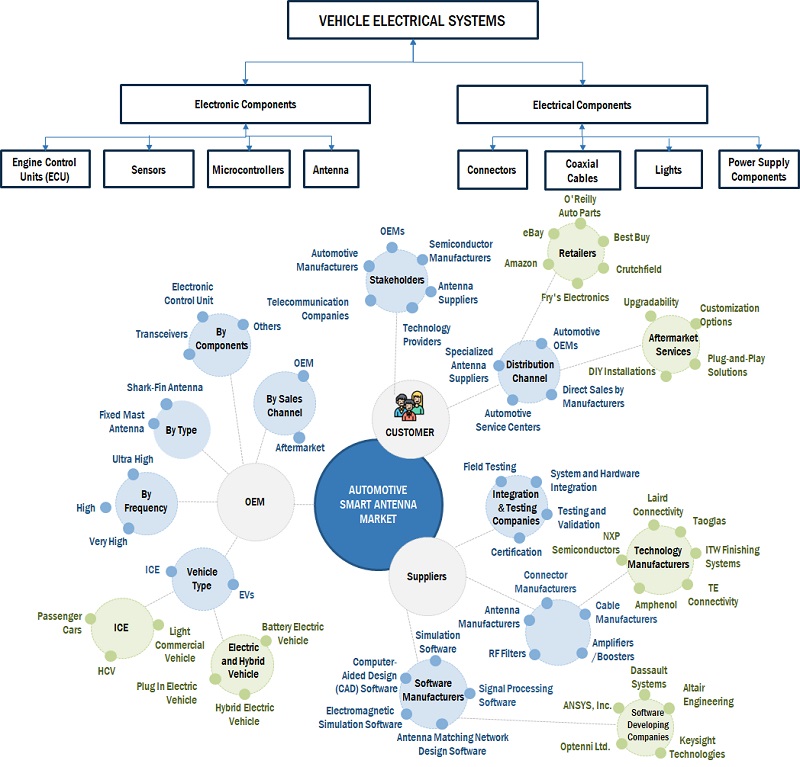
The passenger car segment is estimated to be the largest market during the forecasted period.
Passenger cars contribute to the largest market share of the global vehicle market. These vehicles are the early adopters of new technologies and safety features, some directly related to automotive smart antennas installed in the vehicles. Features such as ADAS, V2X, collision avoidance systems, adaptive cruise control, pedestrian safety, and intersection movement assist (IMA) are some of the features offered by major OEMs in their premium and luxury vehicles, owing to the need for smart antennas in vehicles. Adding further In-vehicle entertainment has witnessed significant advancements, contributing to an increased focus on enhancing the overall driving experience. Modern vehicles are increasingly equipped with sophisticated infotainment systems, providing many entertainment options for drivers and passengers. Features such as integrated navigation, audio/video playback, Apple CarPlay, and Android Auto are offered in the vehicle, which requires smart antenna to enjoy the personalized driving experience seamlessly.
The advent of autonomous vehicles is expected to have a transformative impact on the smart antenna market, driving increased demand for advanced communication technologies. Autonomous vehicles rely on real-time data exchange and seamless communication to navigate, make decisions, and ensure safety. Smart antennas play a crucial role in facilitating Vehicle-to-Everything (V2X) communication, allowing autonomous vehicles to interact with each other, infrastructure, and pedestrians. These antennas enable the transmission and reception of data related to the vehicle's surroundings, traffic conditions, and potential hazards. In the US, The Jaguar I-PACE electric SUV is used by Waymo's fleet, first introduced in March 2022. It offers Waymo's self-driving technology, smoother handling, faster acceleration, and a more luxurious interior. As the deployment of autonomous vehicles becomes more widespread, the smart antenna market is poised to experience substantial growth, providing the essential communication infrastructure for these advanced vehicles' safe and efficient operation.
The rapid growth of telecom infrastructure is a key driving force behind the increasing adoption of automotive smart antennas in passenger cars. The widespread deployment of 4G and the impending arrival of 5G networks create a robust data highway for smart antennas, which have paved the way for advanced connectivity features in vehicles. As telecom infrastructure evolves, passenger cars are becoming integral components of the broader Internet of Things (IoT) ecosystem, benefiting from seamless communication, real-time data exchange, and improved connectivity on the road. Ford (US), in March 2022, announced that it would invest USD 50 billion in commitment for the electrification of all vehicle types by 2026.
As the digital age expands, passenger cars will be equipped with more advanced features like real-time information that empowers smoother journeys, innovative technology that enhances safety, and the possible advent of interconnected cars, which will need automotive smart antennas.
Ultra-high frequency is the fastest-growing frequency segment for the automotive smart antenna market.
The ultra-high frequency for automotive smart antennas ranges from 2000 to 6000 MHz. This application or frequency is based on long-range communication. Applications such as satellite radio (SDARS), digital video broadcasting (DVB), cellular connectivity, WLAN, and V2V communication fall under ultra-high frequency. The ultra-high frequency segment is expected to be the fastest-growing segment of the market owing to an increase in connected cars. The connected car concept has brought the next growth cycle of the automotive sector with a rise in convenience and safety features.
Compared to lower frequencies, Ultra-high offers significantly higher bandwidth, enabling faster data transmission, which is crucial for next-generation connected car applications like Cellular V2X communication, real-time traffic updates, and even high-definition in-car entertainment streaming. This bandwidth advantage future-proofs vehicles for the ever-increasing data demands of connected car technologies. Also, the higher frequencies are less susceptible to interference from common sources like buildings and other vehicles. This translates to more reliable and stable data connection, especially in crowded urban environments, ensuring seamless communication for critical safety applications like collision avoidance and traffic flow optimization.
Vehicles such as Mercedes-Benz S-Class, BMW iX Flow, Audi e-tron GT, Genesis GV70, and Porsche Taycan are few examples of Luxury cars that are mostly equipped with advanced connectivity features, including high-speed internet, in-car Wi-Fi, sophisticated infotainment systems, advanced autonomous driving capabilities, and ADAS features that rely on robust communication systems, where smart antennas with ultra-high-frequency bands enhance the performance of these systems by ensuring reliable and efficient data exchange to increase the safety and in-car experience. According to MarketsandMarkets' analysis, premium car sales have increased by 11.3% from 2019 to 2022. Hence, it will create more opportunities for key automotive players.
BEVs hold the largest market share in the electric vehicles type segment for automotive smart antennae.
The automotive smart antenna market has witnessed a shift in consumer preference for BEVs, which has led to wide adoption of smart antennas. The BEVs are the ideal platform with advanced antenna technology equipped with sensors, processors, and communication modules. This intricate network relies heavily on robust and dependable smart antennas for several critical functions.
Considering the regional investments in the US, the Bipartisan Infrastructure Investment group had invested USD 550 billion in August 2021 which also included V2X technology deployment for US roads, including funding for the purchase and installation of compatible vehicle equipment. Also, the US governing body has allocated a subsidy for EVs with a tax credit of USD 7,500 to purchase new BEVs, indirectly supporting the adoption of smart antennas as they are becoming standard features in many models. Also, several EU member states have offered their national subsidies of USD 5,440 for purchasing BEVs under the French Bonus écologique scheme to increase the sales of BEV vehicles manufactured in France over Chinese EVs. The rising sales of BEVs in Europe and US are expected to increase the demand for smart antennae in electric cars during the forecast period.
According to MarketsandMarkets analysis, the global Electric vehicles market is valued at USD 388.1 in 2023 and is expected to grow to USD 951.9 billion in 2030 at a CAGR of 13.7%. Hence, these increasing sales of EVs with government subsidies and investments in infrastructure will drive the BEVs market for the automotive smart antenna market.
Asia Pacific holds the largest share of the automotive smart antenna market.
The Asia-Pacific region has emerged as a stronghold for the automotive smart antenna market, primarily fueled by the dynamic growth of its automotive industry and the rapid adoption of advanced technologies. Notably, major automotive markets such as China, Japan, South Korea, and India have been at the forefront of this trend. The surge in connected vehicle technologies has played a pivotal role, with smart antennas being a critical component for seamless communication between vehicles and the evolving smart infrastructure. The deployment of 5G connectivity has further accelerated the demand for smart antennas, mainly as they facilitate high-speed, low-latency communication crucial for advancing autonomous vehicles. In July 2023, Telcos (Israel) planned to invest USD 259 billion till 2030 in the Asia Pacific region for 5G.
Investments and collaborations between the region's automotive manufacturers and technology firms have spurred the development of innovative smart antenna solutions. The partnerships between local automotive companies and global tech players highlight the commitment to integrating advanced communication systems into vehicles. For instance, Tata Motors (India) and Microsoft (US) collaborated to build connected car platforms and integrate Microsoft Azure cloud services for advanced in-vehicle features. Government initiatives and supportive regulations have also contributed to the growth of smart antenna technologies, with policymakers recognizing their role in enhancing safety and connectivity. The consumer preferences for advanced vehicle features and the rising adoption of electric and hybrid vehicles further underscore the significance of smart antennas in the Asia-Pacific automotive market.
China has the major dominance in the Asia-Pacific region for the automotive smart antenna market due to their strategic investments and supportive policies. The Chinese government has pushed EVs and smart transportation systems, increasing the demand for advanced technologies like smart antennas. Partnership between OEMs and component manufacturers has also boosted smart antennas' growth. For instance, Huawei and Great Wall Motors signed a partnership agreement in June 2020 to develop smart EVs. This collaboration emphasizes the integration of Huawei's expertise in 5G technology and smart antennas with Great Wall Motors' capabilities in electric vehicle manufacturing. Such initiatives reflect the broader trend in China, where automotive players actively invest in smart antenna technologies to meet the rising demand for connected and autonomous vehicles, solidifying China's position as a frontrunner in the market.
The Asia Pacific region is a dominant market in the automotive smart antenna sector, resulting in confluence of factors, including robust industry growth, technological advancements, strategic investments, and collaborative efforts between key stakeholders.
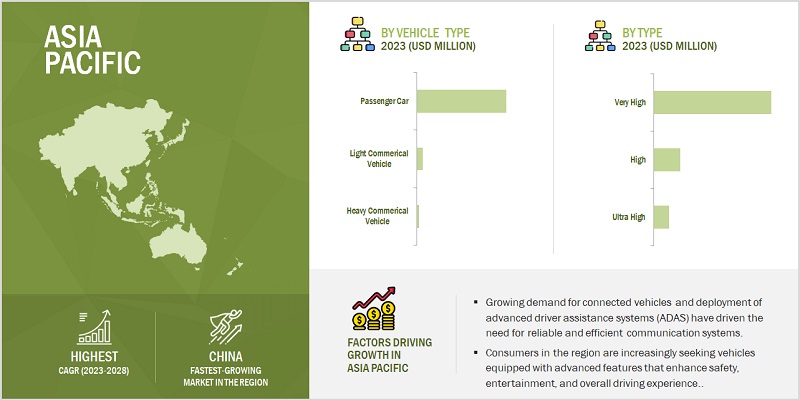
Key Market Players
Major manufacturers in the Automotive smart antenna market includes major players in the market such as Continental AG (Germany), Denso Corporation (Japan), TE Connectivity (Switzerland), Forvia (France), and Ficosa Internacional SA (Spain).
Get online access to the report on the World's First Market Intelligence Cloud
- Easy to Download Historical Data & Forecast Numbers
- Company Analysis Dashboard for high growth potential opportunities
- Research Analyst Access for customization & queries
- Competitor Analysis with Interactive dashboard
- Latest News, Updates & Trend analysis
Request Sample Scope of the Report
Get online access to the report on the World's First Market Intelligence Cloud
- Easy to Download Historical Data & Forecast Numbers
- Company Analysis Dashboard for high growth potential opportunities
- Research Analyst Access for customization & queries
- Competitor Analysis with Interactive dashboard
- Latest News, Updates & Trend analysis
|
Report Attribute |
Details |
|
Market size available for years |
2018–2030 |
|
Base year considered |
2022 |
|
Market Growth forecast |
USD 5.12 Billion by 2030 from USD 2.50 Billion in 2023 at 10.9% CAGR |
|
Forecast period |
2023–2030 |
|
Forecast units |
Value (USD Million/Billion) |
|
Segments Covered |
Vehicle Type, Frequency, Type, Sales Channel, Component Type, and Electric Vehicle Type |
|
Geographies covered |
Asia Pacific, North America, Europe, and Rest of the World. |
|
Top Players |
Continental AG (Germany), Denso Corporation (Japan), TE Connectivity (Switzerland), Forvia (France), and Ficosa Internacional SA (Spain). |
With the given market data, MarketsandMarkets offers customizations per the company’s specific needs.
The study segments the automotive smart antenna market:
Automotive Smart Antenna Market, By Vehicle Type
- Passenger Car
- Light Commercial Vehicles
- Heavy Commercial Vehicles
Automotive Smart Antenna Market, By Frequency
- High
- Very High
- Ultra High
Automotive Smart Antenna Market, By Sales Channel
- OEM
- Aftermarket
Automotive Smart Antenna Market, By Component Type
- Transceiver
- Electronic Control Unit (ECU)
- Others (Connector, Wire Harness, and Digital Bus)
Electric Vehicle Type
- Battery Electric Vehicle (BEV)
- Fuel Cell Electric Vehicle (FCEV)
- Plug-in Hybrid Vehicle (PHEV)
Automotive Paints Market, By Region
- North America
- Europe
- Asia Pacific
- Rest of the World
Recent Developments
- In January 2022, Denso developed Global Safety Package 3, an active safety system designed to improve the safety of vehicles by giving them high sensing capability of their surroundings. This package combines a millimeter-wave radar sensor and a vision sensor for excellent vehicle safety. To reduce the cost and size, the company has reduced the number of parts compared to the previous generation. In this package, the company uses multiple-input and multiple-output (MIMO) technology, which has A compact antenna with only a few channels for transmitting and receiving radio signals. This feature has been used in THE Hino Ranger (Japan), Lexus (Japan) NX, and the Toyota (Japan) Noah and Voxy.
- In August 2023, TE Connectivity launched FP20 and FP40, which were multi-port antennas combining several functions like LTE/5G, Wi-Fi 6E/7, and Bluetooth into one, simplifying installation, reducing roof clutter, and boosting aesthetics. The passenger will experience faster internet, reliable navigation, and smoother Bluetooth connections. It comes with future-proof 5G and Wi-Fi 6E/7 support. These antennas are specially designed for connected cars.
- In March 2023, Continental AG and HERE Technologies announced a partnership agreement to integrate HERE's high-definition (HD) map data with Continental's C-V2X solutions. This combination provides vehicles with precise location information. It enables them to communicate with each other and surrounding infrastructure, enhancing safety and efficiency on the road with the help of smart antennas.
- In October 2022, Denso Corporation and DESAY SV Automotive Co., Ltd. (DESAY SV) established a joint venture to develop and manufacture smart antenna systems for connected vehicles. This partnership strategically combined the strengths of both companies, such as Denso Corporation's expertise in RF technology and antenna design, strong R&D capabilities, and global manufacturing footprint. In contrast, Desay SV shared its automotive infotainment systems and ADAS technologies, and it has a strong presence in the Chinese automotive market.
- In January 2022, Continental AG signed a partnership agreement with NXP Semiconductors to develop and commercialize next-generation radar sensors and software solutions for ADAS and autonomous driving applications. This partnership leveraged NXP's high-performance radar chipsets and Continental's expertise in radar sensor design and software development to deliver innovative solutions for the future of mobility.
Frequently Asked Questions (FAQ):
What is the current size of the automotive smart antenna market?
The automotive smart antenna market is estimated to be USD 2.5 billion in 2023 and is projected to reach USD 5.2 billion by 2030 at a CAGR of 10.9%.
What are the driving factors of the automotive smart antenna market?
Growing cellular applications for connected vehicles, increasing demand for safety features in vehicles, rise in Electrical/Electronic (E/E) architecture, and increase in sales of electric vehicles is driving the automotive smart antenna market will drive the automotive smart antenna market.
Who are the top key players in the automotive smart antenna market?
Major manufacturers in the Automotive smart antenna market include Continental AG (Germany), Denso Corporation (Japan), TE Connectivity (Switzerland), Forvia (France), and Ficosa Internacional SA (Spain). These companies focus on developing new products and partnerships, undertake collaborations, and mergers & acquisitions to gain traction in this growing automotive paints market.
What are the trends in the automotive smart antenna market?
Participants like telematics, in-car infotainment, and connected vehicle features are expected to see growth opportunities as the automotive usage-based insurance ecosystem develops.
What are the challenges faced by automotive smart antenna manufacturers globally?
An increase in cybercrimes for vehicles equipped with connected car features and interference with metal objects reduces the reception frequency quality.
What are the key growth opportunities for automotive smart antenna suppliers?
The aftermarket solution, collaborations, and partnerships will have key growth opportunities for automotive antenna suppliers. .
To speak to our analyst for a discussion on the above findings, click Speak to Analyst
Various secondary sources, directories, and databases have been used to identify and collect information for an extensive automotive smart antenna market study. The study involved four main activities in estimating the current size of the automotive smart antenna market: secondary research, validation through primary research, assumptions, and market analysis. Exhaustive secondary research was carried out to collect information on the market, such as the antenna type and the upcoming technologies and trends. The next step was to validate these findings, assumptions, and market analysis with industry experts across the value chain through primary research. The top-down approach was employed to estimate the complete market size for different segments considered in this study.
Secondary Research
In the secondary research process, various secondary sources have been used to identify and collect information useful for an extensive commercial study of the automotive smart antenna market. Secondary sources include company annual reports/presentations, press releases, industry association publications [such as publications on vehicle sales, EEA (European Energy Agency), IEA (International Energy Agency), ACEA (European Automobile Manufacturers Association), T&E (Transport and Environment), country-level automotive associations and trade organizations, and the US Department of Transportation (DOT)], Automotive smart antenna related magazine articles, directories, technical handbooks, World Economic Outlook, trade websites, and technical articles. Additionally, secondary research has been carried out to understand the average cost of automotive smart antennas equipped in each vehicle type and the historical sales of vehicles.
Primary Research
In the primary research process, various primary sources from both the supply and demand sides were interviewed to obtain qualitative and quantitative information on the market. The primary sources from the supply side included industry experts such as CXOs, vice presidents, directors from business development, marketing, product development/innovation teams, and related key executives from various key companies. Various system integrators, industry associations, independent consultants/industry veterans, and key opinion leaders were also interviewed.
In the primary research process, various primary sources from both the supply and demand sides have been interviewed to obtain qualitative and quantitative information for this report. The primary sources from the supply side include industry experts such as research and development experts, CEOs, CTOs, COOS, vice presidents, marketing directors, technology and innovation directors, and related key executives from different key companies operating in the automotive smart antenna market.
After the complete market engineering, which includes calculations for market statistics, market breakdown, market size estimations, market forecasting, and data triangulation, extensive primary research has been conducted to gather information and verify and validate the critical numbers arrived at. Primary research has also been conducted to identify and validate the segmentation, industry trends, key players, competitive landscape, and market dynamics, such as drivers, restraints, opportunities, challenges, industry trends, and key strategies. Extensive qualitative and quantitative analysis has been performed on the complete market engineering process to list key information/insights throughout the report.
After interacting with industry experts, we have also conducted brief sessions with highly experienced independent consultants to reinforce the findings from our primaries. This, along with the in-house subject matter expert’s opinions, has led us to the findings described in this report's remainder.
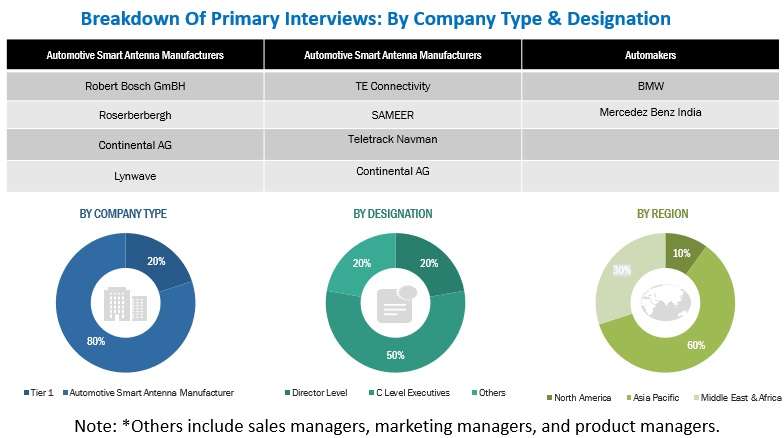
To know about the assumptions considered for the study, download the pdf brochure
Market Size Estimation
A detailed market estimation approach was followed to estimate and validate the value of the automotive smart antenna market and other dependent submarkets, as mentioned below:
- Key players in the automotive smart antenna market were identified through secondary research, and their global market shares were determined through primary and secondary research.
- The research methodology included the study of annual and quarterly financial reports, regulatory filings of major market players (public), and interviews with industry experts for detailed market insights.
- All industry-level penetration rates, percentage shares, splits, and breakdowns for the automotive smart antenna market were determined using secondary sources and verified through primary sources.
- All key macro indicators affecting the revenue growth of the market segments and sub-segments have been accounted for, viewed in extensive detail, verified through primary research, and analyzed to get the validated and verified quantitative and qualitative data.
- The gathered market data was consolidated and added with detailed inputs, analyzed, and presented in this report.
Automotive Smart Antenna Market: Bottom-Up Approach
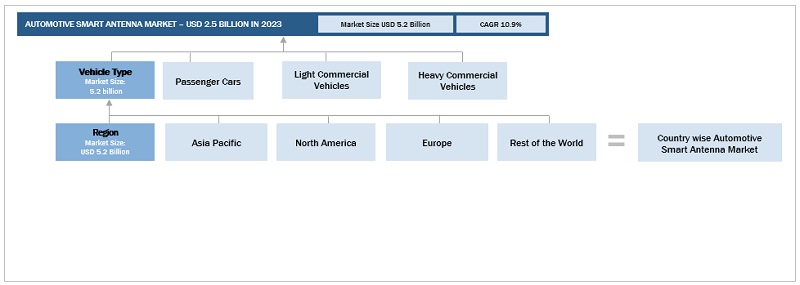
To know about the assumptions considered for the study, Request for Free Sample Report
Automotive Smart Antenna Market: Top-Down Approach
- The top-down approach has been used to estimate and validate the size of the automotive smart antenna market, by frequency. The market share of each technology was derived at the regional level through secondary research & insights from industry experts. Further, the market was segmented based on market share for each frequency type at a regional level. A similar approach is used in EVs type, Type, and component type segments.
Top-Down Approach Automotive Smart Antenna Market For Frequency At The Regional Level

Bottom-Up Approach Automotivesmart Antenna By Type At Regional Level
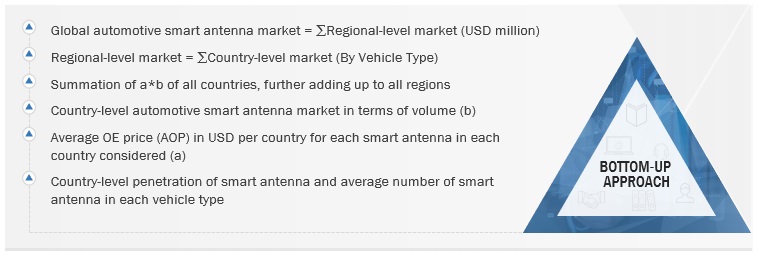
Data Triangulation
The market was split into several segments and sub-segments after arriving at the overall market size—using the market size estimation processes as explained above. Where applicable, data triangulation and market breakdown procedures were employed to complete the overall market engineering process and arrive at the exact statistics of each market segment and sub-segment. The data was triangulated by studying various factors and trends.
Market Definition
Smart antennas utilize sophisticated signal processing techniques to improve V2V communication performance. They can dynamically adjust the radiation pattern towards the intended receiver, optimizing signal strength while minimizing interference. The adaptive beamforming features of smart antennas facilitate precise communication, particularly in challenging scenarios characterized by obstacles or signal fading. Its features include 4G (LTE)/5G, GPS, passive key entry, tire pressure monitoring system (TPMS), in-build Wi-Fi system, radio/FM, digital audio broadcasting and C-V2X. These features are used for high-speed data transfer, e-call, telematics systems, navigation systems, and to increase vehicle safety.
Stakeholders
- Automotive smart antenna manufacturers
- Automotive electronic component and software suppliers
- Automotive original equipment manufacturers (OEMs)
- Government regulatory bodies
- Telecommunication companies
- Automotive testing and certification services
- Automotive aftermarket suppliers
- Fleet management companies
- Satellite communication providers
- Insurance companies
- Cybersecurity firms
Report Objectives
-
To define, describe, and forecast the automotive smart antenna market, in terms of value
(USD million), based on the following segments: - Vehicle Type ((Passenger Car, Light Commercial Vehicle (LCV), and Heavy Commercial Vehicle (HCV))
- Frequency (High, Very High, and Ultra High)
- Type (Shark-Fin Antenna and Fixed Mast Antenna)
- Component Type ((Transceiver, Electronic Control Unit (ECU), and Others (Connector, Wire Harness, and Digital Bus))
- Sales Channel (OEMs and Aftermarket) (qualitative data only)
- Electric Vehicle (EV) Type (Battery Electric Vehicle (BEV), Plug-in Hybrid Vehicle (PHEV), and Fuel-cell Electric Vehicle (FCEV))
- Region ((Asia Pacific, Europe, North America, and Rest of the World (RoW))
- To understand the market dynamics (Drivers, Restraints, Opportunities, and Challenges) and conduct Patent Analysis, Pricing Analysis, Recession Impact, Key Buying Criteria, Trade Analysis, Technology Analysis, ASP Analysis, Trades and Conferences, Case Study Analysis, Supply Chain Analysis, Regulatory Analysis, Key Conference and Events, and Ecosystem Mapping
- To understand the dynamics of the market players and distinguish them into stars, emerging leaders, pervasive players, and participants according to their product portfolio strength and business strategies.
- To strategically analyze markets with respect to individual growth trends, prospects, and contributions to the total market
- To analyze recent developments, such as partnerships, supply agreements, joint ventures/mergers and acquisitions, geographic expansions, and product developments of key players in the market
Available Customizations
Along with the market data, MarketsandMarkets offers customizations in accordance with company-specific needs.
The following customization options are available for the report:
Automotive Smart Antenna Market, By Frequency And Country
- Asia Pacific
- North America
- Europe
- RoW
Note:- We can cover countries like US, Canada, and Mexico from North America; Germany, France, Italy, Spain, and UK from Europe; China, India, Japan, and South Korea from Asia Pacific region; and Brazil and Iran from Rest of the World.
Automotive Smart Antenna Market, By Type And Country
- Asia Pacific
- North America
- Europe
- RoW
Note:- We can cover countries like US, Canada, and Mexico from North America; Germany, France, Italy, Spain, and UK from Europe; China, India, Japan, and South Korea from Asia Pacific region; and Brazil and Iran from Rest of the World.












Growth opportunities and latent adjacency in Automotive Smart Antenna Market